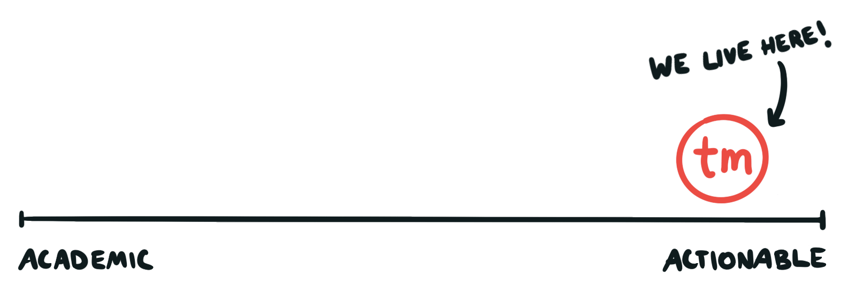Research at Thinkmill is actionable
The product development process is rarely a linear affair. With new problems and solutions being discovered each day, user research needs to be flexible and pragmatic to aid the creative process, rather than hinder it. That’s why at Thinkmill, we focus on research that delivers actionable insights – outcomes that can be directly and immediately translated into the project and across the team.


To ensure the research outcomes are actionable, there are few techniques we employ. We always use the current project context and timeline to develop a realistic research plan to ensure timely feedback. Because all our researchers are also practitioners, they understand the type of insights required to progress the project. Additionally, we involve engineers and leadership in the research sessions and playbacks so they can hear what real-world users have to say, deepening their empathy and understanding of the users’ needs, drivers and pain points. This first-hand experience also helps to ensure the research findings are taken onboard and have a meaningful impact within the organisation.
A typical research cycle
Though we will design each research plan to fit the context of the project, our typical research cycle normally includes the following steps:
- Understanding the ask - Through discussion and conversation with project stakeholders, we uncover the questions we’re looking to answer through the research effort, as well as the level of clarity we need to get to.
- Designing the research - Our research specialists decide on the best research methodologies and approach to answer the defined questions. The methodologies we specialise in can be found on our User Research page.
- Defining participants - In collaboration with project stakeholders and subject-matter experts, we identify the types of participants who will best help us uncover the insights we seek, as well as whether an incentive will be provided. The metrics for defining the participants are based on the context of the research project and can include things like level of expertise, company size, familiarity with the product or service, etc. We then define a plan to recruit them.
- Recruitment and set up - We create the parameters to recruit the desired participants and organise the recruitment through either third-party user research services, or the existing user base of the product or service. We also create any artefacts needed for the sessions based on the selected research methodologies and designed session structure.
- Facilitate the sessions - Now it’s time to conduct the sessions with the recruited participants. We take detailed notes, and where permitted and appropriate, record the sessions. We encourage key stakeholders to attend sessions as a learning exercise and to increase the impact of the findings within the team.
- Analyse to establish actionable insights - Our research specialists then synthesise the recordings and notes to uncover patterns and insights from the sessions. The findings come with actionable insights that teams can apply to the project immediately.
- Document and playback - We also prepare the insights into a report that is presented back to the key stakeholders and the broader team. This document acts as a stand-alone report of the research findings which the team can refer to in the future.
Growing user research maturity
At Thinkmill we have experience working with organisations that are taking their first steps into research, as well as ones that are looking to build a permanent research capability within their team.
First steps into user research
When working with an organisation that is new to user research, our goal is to help build an understanding of the value of research within the team. Research can help to achieve the following:
- Ensure the product or service meets users’ needs
- De-risk projects by validating with real users
- Provide guidance for product direction
- Give confidence to project teams
- Create alignment through research-backed data
- Reduce prevalence of personal opinions and biases in product discussions
- Establish a process that will enable future rounds of research
- Present findings in a standalone report that can be referred to again and again
Building a culture of UX research
Once the initial value of user research has been accepted by the team, we can begin to embed it into the product development cycle, which means:
- Small and iterative research cycles that guide product decisions
- A culture of using research to answer product questions rather than relying on opinion
- An understanding that a week of research upfront will save time and cost later in the project
Talk to us about user research
If the principles and methodology outlined here sounds like something that could benefit your project, have a chat with us today. We believe that user research can bring valuable insights to any stage of a project and are excited to work with teams who are ready to reach out to their user base and uncover how to improve their products.

